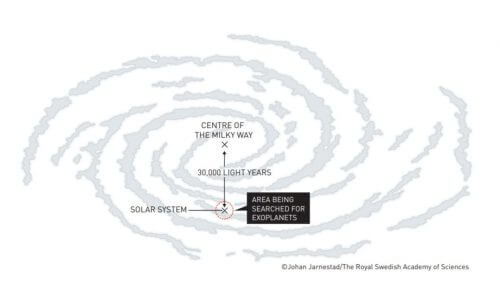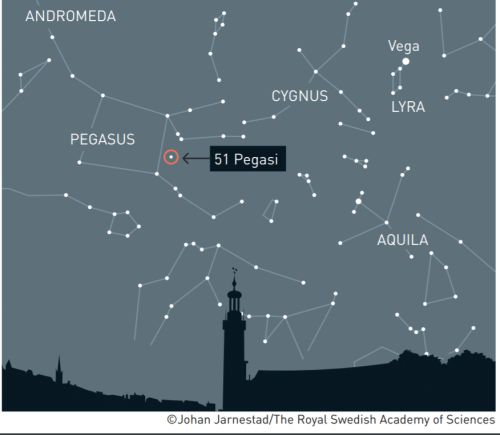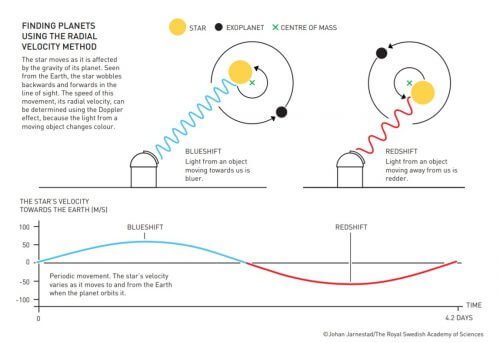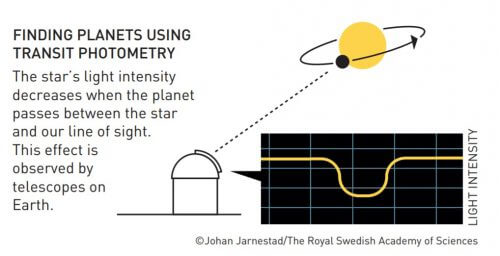An extended article translated from the Nobel Prize website describing the importance of the prize given to the discoverers of the first planet outside the solar system

2019 Nobel laureates in physics Michel Mayor and Didier Queloz studied our home galaxy, the Milky Way, with the aim of uncovering unknown worlds. In 1995 they revealed their first discovery of a star outside our solar system, an extrasolar star around a sun-like star, dubbed 51 Pegasi b.
The discovery of two of the 2019 Nobel Prize winners in physics, Michel Mayor and Didier Cavalloz, started a real revolution in the field of astronomy and since their first discovery, another 4000 extrasolar stars have been discovered in the Milky Way galaxy. Strange new worlds are still being uncovered from time to time today, worlds of a huge variety of sizes, shapes and orbits, most of which are nothing like our own, which includes the sun and the holiday planets around it. These discoveries led researchers to develop new theories regarding the physical processes responsible for the creation of stars.
The first star around the sun is different

Most cosmologists today agree that the Big Bang model is indeed the most likely scenario regarding the origin of the universe and its development, although only five percent of its matter and energy are known today. This small portion of matter eventually clustered together to create everything that exists around us - stars, planets, trees and flowers, and also humans. Are we the only ones looking out at the universe? Is there life elsewhere in the universe, on the holiday planet around another sun? No one knows. However, we know today that our sun is not the only one that is a center for the holiday planets around it, and that most of the hundreds of millions of stars in the Milky Way have planets accompanying them. Astronomers currently know of more than four thousand stars outside our solar system. Strange new worlds have been discovered, worlds unlike our own star system. The first one discovered was so strange that no one in the scientific community believed in its existence; The planet was too big to be so close to its sun.
Michel Mayor and Didier Cavaloz announced their sensational discovery at an astronomy conference held in Florence on October 1995, 51. It was the first scientifically proven planet orbiting a Sun-like star. The planet, 51 Pegasi B, is speeding around its sun, XNUMX Pegasi, which is fifty light years from Earth. Its rotation around the sun lasts four days, which means its orbit is close to the sun - only eight million kilometers from it. Its sun heats the planet to a temperature of more than a thousand degrees Celsius. Things are much calmer on Earth, which completes one revolution around the Sun in one year and is one hundred and fifty million kilometers away from it.
The discovered planet was also found to be a surprisingly large star - a ball of gases equal in size to the largest gas giant in the solar system, Jupiter. Compared to Earth, Jupiter's volume is three hundred times greater and it weighs three hundred times its weight. According to previous models of how planetary systems form, Jupiter-sized planets should have formed farther from their sun, and their orbits should have taken longer to complete. Jupiter takes almost twelve years to complete one revolution around the Sun, so the short time it took for the planet 51 Pegasi B to complete a complete revolution was a complete surprise to researchers looking for planets of its type. They were looking in the wrong place.
Almost immediately after the discovery was made known, two American astronomers, Paul Butler and Geoffrey Marcy, turned their telescopes towards the planet 51 Pegasi and were soon able to confirm the revolutionary discovery of Mayur and Queloz. After only a few months they found two new planets orbiting sun-like stars. Their short completion periods were advantageous to astronomers who did not have to wait months and years to observe the complete rotation around the sun. Now they had time to watch the stars complete one revolution after another.
The starry sky over Stockholm in October. The first planet discovered orbiting a sun-like star that exists outside our solar system is in the constellation Pegasus. It orbited a star called 51 Pegasi, which is visible to the naked eye only when the environment is extremely dark. However, the square of Pegasus is easy to identify.
How did they get so close to their sun? This question challenges existing theory about the origin of stars and has led to new theories describing how gas giants formed at the edges of their solar systems, then converged inward toward the host star.
Exact methods that led to the discovery
his age

Sophisticated methods are required to track an extrasolar planet - planets don't shine by themselves, they just reflect sunlight weakly so that their glow is masked by the bright light radiating from their sun. The method used by research groups to find a planet is called the 'radial velocity method'; It measures the motion of the host star as it is affected by the gravity of the star planet around it. When a planet orbits its sun, the sun also moves slightly - they both move around their common center of gravity. From the point of view on Earth, the sun swings back and forth in the line of sight.
The speed of this movement, the radial speed, can be measured using the well-known Doppler effect - light rays coming from an object moving toward us are bluer (wavelength shift to blue), and if the object moves away from us, the rays are redder (wavelength shift to red). This is the same result we hear when the siren of an ambulance increases as it approaches us and decreases as it moves away from us.
The result of the planet, therefore, alternately changes the color of the light coming from the sun from blue or red; These are the changes in the wavelengths of light that astronomers capture with their instruments. The color changes can be accurately determined by measuring the wavelengths of the sun, thus providing a direct measurement of its speed relative to the line of sight.
The biggest challenge lies in the fact that radial velocities are extremely low. For example, the gravity of the planet Jupiter causes the sun to move at a speed of 12 meters per second around the center of gravity of the solar system. The Earth, for example, contributes only 0.09 meters per second, values that require the use of highly sensitive instruments in order to detect extrasolar Earth-like planets. In order to increase accuracy, astronomers measure several thousand wavelengths simultaneously. The light is split into discrete wavelengths using a spectrograph, a device at the core of these measurements.
In the early 1977s, when Didier Cavalloz began his research career at the University of Geneva, Michel Maior had already spent many years studying the movement of the stars, building the measuring instruments himself with the help of other researchers. In 300 Mayur managed to mount the first spectrograph he built on top of a telescope at the Haute-Provence observatory, a hundred kilometers northeast of Marseille. Although this device could detect speeds with a threshold of XNUMX meters per second, this value was still too high to detect the attraction of a planet affecting its sun.
Together with the research group, PhD student Didier Cavaloz was asked to develop new methods for making more precise measurements. The students used several new technologies that made it possible to quickly distinguish many stars and analyze the results on the spot. Optical fibers could now conduct the sun's rays to the spectrograph without distorting them, and the use of better digital image detectors increased the sensitivity of the instruments to light (2009 Nobel Prize in Physics awarded to researchers Charles Kwan Kao, Willard Boyle and George Smith). More powerful computers have allowed researchers to develop custom software for digital image development and data processing.
When construction of the spectrograph was completed in the spring of 1994, the measured velocity was 15-10 meters per second and the first ever discovery of an extrasolar planet was only a matter of time. At the time, the study of extrasolar planets was not part of the mainstream science of astronomy, but Mayor and Quallose decided to announce their discovery. They spent several months refining their results, and in October of 1995 they were ready to present the first discovered extrasolar planet to the scientific world.
The discovery of many worlds

The first discovery of an extrasolar planet around a Sun-like star revolutionized astronomy. Thousands of previously unknown new worlds have been discovered. Today, not only are new star systems discovered by telescopes on the surface of the earth, but such telescopes are also on satellites launched deep into space. The American space telescope TESS is currently scanning more than two hundred thousand stars close to us, while trying to locate Earth-like planets. Even before that, the Kepler space telescope provided tremendous and important information, discovering more than two thousand three hundred extrasolar planets.
Alongside measurements of the changes in the radial velocity of the stars, a method of transit photometry is currently used in the search for extrasolar planets. With this method, changes in the intensity of light coming from the star are measured when the planets around it pass in front of it, when this occurs parallel to our line of sight from Earth. This method also allows astronomers to observe the atmospheres of those planets as the light from the star makes its way to Earth. Sometimes, both methods can be used; The photometry provides information about the size of the planet while the mass can be estimated using the radial velocity method. Then the compactness of the planet can be calculated and its structure can be determined from this.
The discovered extrasolar planets surprised us in terms of the variety of their shapes, sizes and orbits. They challenged the scientific ideas that had previously dominated researchers about star systems and forced researchers to adjust their theories about the physical processes underlying the creation of planets. Thanks to many ventures planned to search for extrasolar planets, we may eventually find an answer to humanity's eternal question: "Is there extra life out there?"
This year's Nobel laureates changed our ideas about the universe. While the theoretical discoveries of James Peebles contributed to our understanding of how the universe evolved after the Big Bang, Michel Mayor and Didier Cavalloz scanned our cosmic neighborhood in search of unknown planets. Their discoveries forever changed our perceptions of the world.
James Peebles, born in 1935 in Winnipeg, Canada. He holds a doctorate from 1962 from Princeton University, USA. Serves as a professor of science at Princeton University.
Michel Mayor, born in 1942 in Lausanne, Switzerland. He holds a doctorate in 1971 from the University of Geneva in Switzerland. Serves as a professor at the University of Geneva.
Didier Cavaloz, born in 1966. He holds a doctorate from 1995 from the University of Geneva in Switzerland. Serves as a professor at the University of Geneva and the University of Cambridge, UK.
More of the topic in Hayadan:
- Prof. Zvi Maza Mauni Tel Aviv: The science of planets outside the solar system is flourishing thanks to the genius of Michel Mayor, and the device he built
- The discoverers of the first planet outside the solar system and the key to the cosmological theory were jointly awarded the Nobel Prize in Physics
- Find out exactly the masses of planets outside the solar system

10 תגובות
Atheist from the gut
They have a single power switch - with a single position...OFF
Just a thought for an atheist:
When you drag a file to the Recycle Bin in the Windows operating system and cause it to be deleted, did the act of dragging itself cause this? It is not just a symbol, so is the shofar... a symbol for humans, which according to their perception represents a cosmic spiritual process that takes place in the backend of the software.
Another thought, when you remember a song in your mind, do you hear the sound waves of the song? No, you hear the essence of the song in your mind. Maybe God can hear the essence of people's thoughts?
points for thinking…
If the learned scientists investigate theories, maybe they will explain why they do not deal with the verses of the Tanakh and the Holy Koran. The name of the Holy One, blessed be He, determines the creation of the heavens and the earth and the direction of all their details and on them and in them.
Friends, 1.000.000 topics in one go. Repeating the question. (Ex-Orthodox) I don't think there is really a contradiction between "God" and the cosmos. It's another name for something we'll never understand. And we are proof today. Since no one came back (and not even an alien..) and the big bang, which is indeed the prevailing theory reasonable to the human mind, does not contradict infinite existence.. before the big bang.. there was probably another bang and there will be more in the future.. call it Cosmos Chaos, God, there is nothing from nothing... there is something. Our mind cannot contain worlds beyond the biological body in which it is located. Therefore there is a choice. Either believe, or not, I chose agnosticism. Regarding the shofar, in my eyes it is only symbolic and nice. At the beginning of the repetition in the question I was very anti-religion. Today I see nice symbols in it. And also many things... because of which I abandoned. But I'm glad I abandoned it knowingly. That doesn't suit me. And I realized one thing. I believe in love. She is the great winner of karma. Even when he wasn't here she would stay. And that, in my opinion, is the thirst for knowledge. How well we can delve deeply into hidden things... even though in my opinion a mystery leads to a mystery... and besides, religious people also believe in the next world. Just in their mirror. I hope after beautiful years to find myself in another beautiful place in the universe and even believe that I was in a similar or different place before I was created. And by the way, religious people believe in this too. They just call it soul etc. Let's agree that we disagree…
The man who confirmed what we knew.
I will come back and say
Our solar system is nothing more than a point in infinity!!! Time is running out!!!
There are unequivocal proofs that there is a G-d who created the heavens and their host. All the big bang theories may be more plausible than others but it is also completely delusional in itself. The chances of something like this happening are very slim.
What do you mean but no one knows? Who the people of the country write nonsense like you?
Everyone and almost everyone knows that there is life outside of Earth. How do you not know funny?
And it is also written in the Holy Zohar if it interests you.
Very interesting article! many thanks!!!
And the second thing.. just a thought that crossed my mind.. so how do you really explain that God does not exist to a group of Hillbillies who actually pray to... nothing and nothing?
And there will be more... Is it true that on Tishrei holidays, it is customary to blow the shofar?
I was just passing by a synagogue on Rosh Hashanah... and the blowing of the shofar was so weak... how could "God" hear it? Sometimes I don't understand how a religious mind works at all.
There is one power switch: on/off.
Maybe this star still feeds on the energy of our sun, if its sun is only figures ???